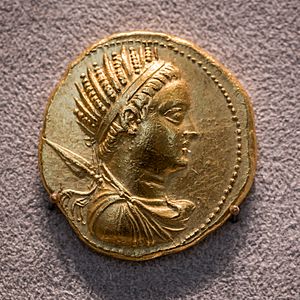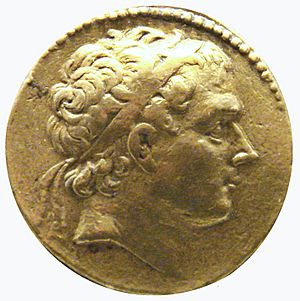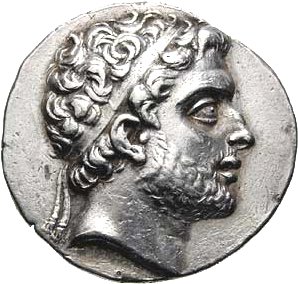Ptolemy V Epiphanes facts for kids
Quick facts for kids Ptolemy V Epiphanes |
|
|---|---|
| Ancient Greek: Πτολεμαῖος Ἐπιφανής Ancient Egyptian: Iwaennetjerwymerwyitu Seteppah Userkare Sekhem-ankhamun |
|

Tetradrachm issued c. 200 BC
|
|
| King of the Ptolemaic Kingdom | |
| Reign | July/August 204–September 180 BC (Ptolemaic dynasty) |
| Predecessor | Ptolemy IV |
| Successor | Ptolemy VI |
| Consort | Cleopatra I |
| Children | Ptolemy VI Ptolemy VIII Cleopatra II |
| Father | Ptolemy IV |
| Mother | Arsinoe III |
| Born | 9 October 210 BC |
| Died | September 180 BC (aged 29) |
| Burial | Alexandria |
Ptolemy V Epiphanes (born October 9, 210 BC – died September 180 BC) was a king of Ptolemaic Egypt. He ruled from July or August 204 BC until his death at age 29. His full name, Ptolemaĩos Epiphanḗs Eucharistos, means "Ptolemy the Manifest, the Beneficent."
Ptolemy V became king when he was only five years old. His parents, Ptolemy IV and Arsinoe III, died in unclear circumstances. A group of powerful advisors, called regents, took control of the kingdom. However, these regents were not very good at their job. This weakness allowed other kings, Antiochus III and Philip V, to attack Egypt. They started the Fifth Syrian War (202–196 BC), and Egypt lost many of its lands. At the same time, a big Egyptian revolt (206–185 BC) broke out. This revolt caused Egypt to lose control of much of its own country.
Ptolemy V officially became an adult king in 196 BC. His coronation in Memphis was celebrated with the creation of the famous Rosetta Stone. He later made peace with Antiochus III and married his daughter, Cleopatra I. Ptolemy V worked to get back control of Egypt's southern regions from the rebels. He succeeded in 186 BC. In his final years, he planned another war against the Seleucid empire, but he died suddenly. His reign showed a big change in power, with Egyptian priests and courtiers becoming more important in how the kingdom was run.
Contents
A Young King's Challenges
Ptolemy V was the only child of Ptolemy IV and his wife, Arsinoe III. His father, Ptolemy IV, was known for enjoying luxury and letting his advisors manage the government. Early in his rule, Ptolemy IV won a war against the Seleucid empire. But later, native Egyptian people started to revolt. By 205 BC, Ptolemy IV had lost control of Upper Egypt to a self-declared pharaoh named Hugronaphor.
Ptolemy V was born in 210 BC. He became a co-ruler with his father soon after. In 204 BC, when Ptolemy V was five, his parents died. It seems there was a fire in the palace that killed his father. It's not clear if his mother died in the fire or was killed to stop her from becoming regent.
Regencies: Ruling for the Young King
After Ptolemy V's parents died, their deaths were kept secret for a short time. Then, the young Ptolemy V was presented to the army and declared king. A powerful advisor named Agathocles became his main regent. Many people believed that the will naming Agathocles as regent was not real.
Agathocles tried to make his rule strong. He gave money to soldiers and sent important people away to other countries. This was to get foreign support and prevent them from challenging his power at home. However, his efforts failed. By late 203 BC, the kings Antiochus III and Philip V of Macedon secretly agreed to divide Egypt's lands between them. War was expected.
The Alexandrian Revolution
Agathocles was very unpopular. People believed he was responsible for the death of Arsinoe III and other important people. In 203 BC, the army and the people of Alexandria revolted. They surrounded the palace, demanding to see the young king.
Ptolemy V, who was about seven years old, was brought out to the people. The crowd demanded that those responsible for his mother's death be punished. Agathocles and his family were then killed by the angry crowd.
After this, a general named Tlepolemus became the new regent. However, people soon turned against him too. He was replaced by Aristomenes, another important advisor.
The Fifth Syrian War (202–196 BC)


Antiochus III had been waiting for a chance to get revenge on Egypt. In 202 BC, he invaded a region called Coele-Syria and took Damascus. Egypt asked Rome for help, but it didn't do much.
In 201 BC, Antiochus III took more land, including Gaza. Meanwhile, Philip V took over other Egyptian territories. This led to a war between Philip V and Rome.
An Egyptian general named Scopas tried to get back the lost lands in Palestine. He succeeded for a short time. But Antiochus III attacked again in 200 BC and defeated Scopas's army. Antiochus III then took full control of Coele-Syria and Judea. These lands never returned to Egyptian control. In 197 BC, Antiochus III also took over many Egyptian cities in Asia Minor.
The Egyptian Revolt (204–196 BC)
While Egypt was fighting the Syrian War, a big revolt continued inside Egypt itself. A native pharaoh named Hugronaphor (Horwennefer) had taken control of Thebes in 205 BC. He was later followed by Ankhmakis (Ankhwennefer).
Ptolemy V's forces tried to take back control. They briefly regained Thebes in 199 BC. However, another group of rebels in the Nile Delta captured the city of Lycopolis. After a siege, the Egyptian army took back Lycopolis. The rebel leaders were taken to Memphis and publicly executed on March 26, 196 BC. This happened during the celebration of Ptolemy V's coronation.
Ptolemy V: Ruling on His Own

By 197 BC, Egypt's poor performance in the war made Aristomenes, the regent, lose his power. Around this time, Ptolemy V was declared an adult king, even though he was only thirteen. His advisors believed that having a king rule on his own would make the kingdom stronger. He was crowned in Memphis on March 26, 196 BC.
The day after his coronation, a meeting of priests from all over Egypt took place. They created the Memphis decree. This decree was carved onto large stone slabs, and two of these still exist today: the Nubayrah Stele and the famous Rosetta Stone. The decree praised Ptolemy V for his good deeds and his victory over the rebels. It also removed some taxes on Egyptian temples. This shows that the priests had gained more power and influence.
Peace with Antiochus III

After the Romans defeated Philip V in 197 BC, they focused on Antiochus III. Rome demanded that Antiochus III return the lands he had taken from Ptolemy V. However, Antiochus III said he was already making peace with Egypt.
Antiochus III then made a peace treaty with Ptolemy V. As part of the agreement, Ptolemy V married Antiochus III's daughter, Cleopatra I. The wedding took place in 194/193 BC. Ptolemy V was sixteen, and Cleopatra I was a bit younger or similar in age. This marriage helped seal the peace between the two kingdoms.
Ending the Egyptian Revolt (196–185 BC)
In the mid-190s BC, the rebel leader Ankhmakis made a deal with King Adikhalamani of Meroe. With help from Meroe, Ankhmakis recaptured Thebes by 195 BC. However, Ptolemy V's general, Comanus, led a successful reconquest. By 190 BC, Thebes was back under Ptolemy V's control.
In 187 BC, Adikhalamani stopped supporting Ankhmakis. On August 27, 186 BC, Ankhmakis and his son made a final attack on Thebes but were defeated. This victory brought all of Upper Egypt back under Ptolemaic rule. Ankhmakis was taken to Alexandria and executed.
To prevent future revolts, a new military governor was appointed for Upper Egypt. Greek soldiers were also settled in villages in the south to act as a permanent army.
The rebels in Lower Egypt continued to fight. In 185 BC, General Polycrates of Argos finally put down the rebellion. He promised the rebel leaders good treatment if they surrendered. However, when they surrendered, they were treated very cruelly and killed. It is debated whether Polycrates or Ptolemy V was responsible for this harsh act.
Foreign Policy After the War
After the Fifth Syrian War, Ptolemy V tried to make Egypt powerful again on the world stage. He wanted to get back the lands lost to the Seleucids, but he had little success. When a war broke out between Rome and the Seleucid empire in 192 BC, Ptolemy V offered help to Rome. However, the Roman Senate refused, perhaps because Ptolemy V had made a separate peace with Antiochus III earlier.
When Antiochus III died in 187 BC, Ptolemy V began planning a new war to take back Coele-Syria. He sent his friend Aristonicus to Greece to hire soldiers. He also renewed alliances with Greek states, offering them gifts and ships. Ptolemy V even entered a chariot team in the Panathenaic Games in Greece to raise his profile.
Ptolemy V died suddenly in September 180 BC, before he turned thirty. Ancient historians say he was poisoned by his advisors. They were supposedly worried that he would take their wealth to pay for the new war against Syria.
Royal Traditions and Egyptian Culture
The Ptolemaic Royal Cult
Ptolemaic Egypt had a special royal cult that honored its kings and queens. This cult included a yearly festival called the Ptolemaia. Ptolemy V was declared the Theos Epiphanes Eucharistos (Manifest, Beneficent God) in 199 BC. His name was added to the title of the High Priest of Alexander the Great, who was very important in official documents.
When Ptolemy V married Cleopatra I, they were both honored as the Theoi Epiphaneis (Manifest Gods). The High Priest's title was changed to include both their names. Deceased queens, like Ptolemy V's mother, Arsinoe III, also had their own cults and priestesses.
Pharaoh's Role and Egyptian Religion
Like the kings before him, Ptolemy V took on the traditional role of a pharaoh. This meant supporting the Egyptian priests. The relationship between the king and the priests was very important. It was often shown through decrees made by priestly meetings.
The Memphis decree, created the day after Ptolemy V's coronation, presented him as the "image of Horus, son of Isis and Osiris." This decree used traditional Egyptian ideas to show the pharaoh as a new Horus, who takes the throne from his father and defeats enemies to bring order. In return for his good deeds, the priests agreed to put up statues of Ptolemy V in temples and celebrate his birthday every year.
After the revolt was put down in 186 BC, the priests passed another decree. They agreed to put up another statue of Ptolemy V as "Lord of Victory" in every temple. They also decided to celebrate a festival for Ptolemy V and Cleopatra I each year. These decrees show the growing power of the priests and their importance to the king.
Ptolemy V's ancestors had built many temples to gain the support of the priests. Ptolemy V could not do this as much because Egypt was facing financial difficulties and had lost land to rebels. Most of his building projects were in northern Egypt, especially around the Apis Bull sanctuary and the temple of Anubis in Memphis. This might have been an effort to make Memphis a more important religious center than Thebes, which had been a rebel stronghold.
Family and Children
Ptolemy V married Cleopatra I, the daughter of the Seleucid king Antiochus III, in 194 BC. They had three children who would later rule Egypt, often with much conflict among themselves.
| Name | Image | Birth | Death | Notes |
|---|---|---|---|---|
| Ptolemy VI |  |
May/June 186 BC | 145 BC | Became king after his father's death in 180 BC. He ruled with his mother as regent. He later ruled with his sister and wife, Cleopatra II. |
| Cleopatra II |  |
186-184 BC | 6 April 115 BC | She ruled with her brother and husband, Ptolemy VI. She also ruled with her other brother, Ptolemy VIII, and later with her daughter and grandson. |
| Ptolemy VIII |  |
c. 184 BC | 26 June 116 BC | He ruled with Ptolemy VI and Cleopatra II for a time. He later became king of Cyrenaica and then ruled Egypt again with Cleopatra II and Cleopatra III. |
See also
 In Spanish: Ptolomeo V para niños
In Spanish: Ptolomeo V para niños

